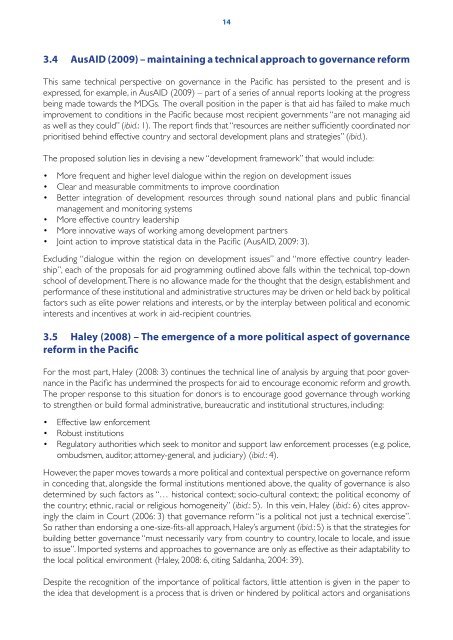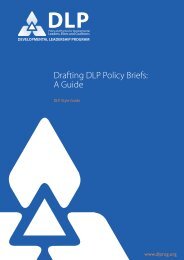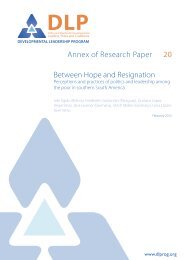143.4 AusAID (2009) – maintaining a technical approach to governance reformThis same technical perspective on governance in the Pacific has persisted to the present and isexpressed, for example, in AusAID (2009) – part of a series of annual reports looking at the progressbeing made towards the MDGs. <strong>The</strong> overall position in the paper is that aid has failed to make muchimprovement to conditions in the Pacific because most recipient governments “are not managing aidas well as they could” (ibid.: 1). <strong>The</strong> report finds that “resources are neither sufficiently coordinated norprioritised behind effective country and sectoral development plans and strategies” (ibid.).<strong>The</strong> proposed solution lies in devising a new “development framework” that would include:• More frequent and higher level dialogue within the region on development issues• Clear and measurable commitments to improve coordination• Better integration of development resources through sound national plans and public financialmanagement and monitoring systems• More effective country leadership• More innovative ways of working among development partners• Joint action to improve statistical data in the Pacific (AusAID, 2009: 3).Excluding “dialogue within the region on development issues” and “more effective country leadership”,each of the proposals for aid programming outlined above falls within the technical, top-downschool of development. <strong>The</strong>re is no allowance made for the thought that the design, establishment andperformance of these institutional and administrative structures may be driven or held back by politicalfactors such as elite power relations and interests, or by the interplay between political and economicinterests and incentives at work in aid-recipient countries.3.5 Haley (2008) – <strong>The</strong> emergence of a more political aspect of governancereform in the PacificFor the most part, Haley (2008: 3) continues the technical line of analysis by arguing that poor governancein the Pacific has undermined the prospects for aid to encourage economic reform and growth.<strong>The</strong> proper response to this situation for donors is to encourage good governance through workingto strengthen or build formal administrative, bureaucratic and institutional structures, including:• Effective law enforcement• Robust institutions• Regulatory authorities which seek to monitor and support law enforcement processes (e.g. police,ombudsmen, auditor, attorney-general, and judiciary) (ibid.: 4).However, the paper moves towards a more political and contextual perspective on governance reformin conceding that, alongside the formal institutions mentioned above, the quality of governance is alsodetermined by such factors as “… historical context; socio-cultural context; the political economy ofthe country; ethnic, racial or religious homogeneity” (ibid.: 5). In this vein, Haley (ibid.: 6) cites approvinglythe claim in Court (2006: 3) that governance reform “is a political not just a technical exercise”.So rather than endorsing a one-size-fits-all approach, Haley’s argument (ibid.: 5) is that the strategies forbuilding better governance “must necessarily vary from country to country, locale to locale, and issueto issue”. Imported systems and approaches to governance are only as effective as their adaptability tothe local political environment (Haley, 2008: 6, citing Saldanha, 2004: 39).Despite the recognition of the importance of political factors, little attention is given in the paper tothe idea that development is a process that is driven or hindered by political actors and organisations
15with different and potentially competing interests. <strong>The</strong> recognition that ‘politics matters’ to developmentis only made at a superficial level. ‘Governments’ are treated as homogenous and singular entities(rather than partisan political organizations often composed of contending elites) – as in the claim that“Successful reform requires local buy-in and ownership as well as sustained commitment … and ishighly unlikely to be achieved in the absence of government commitment (Haley, 2008: 6, citing Collierand Dollar, 2001: 14). In the same fashion, ‘culture’ and ‘context’ are spoken of as if they are brute factsabout a country like population size or GDP (rather than themselves the site of political contestation,conflicting interpretation and power-play) - as in the claim, regarding governance reform, that “thesuccess of efforts will be contingent on a wide range of factors, including the prevailing socio-culturalcontext” (Haley, 2008: 6).3.6 Earlier AusAID studies note the importance of politics and leadershipbut still retain the focus on institutions and technical assistanceAs shown in the previous sub-section, it is not always the case that authors can be identified exclusivelywith either a technical or a political approach. It is not unusual for a paper, report or policystatement to fall at some point on the spectrum between two extremes and to contain nods in bothdirections. So, for example, whilst the analysis and prescriptions in AusAID (2003a) are for the greaterpart technical, one of the conclusions is a politically informed appeal for “increasingly robust dialogueat senior political levels to encourage reform efforts” (ibid.: 16). Here we see a gesture to the idea thatinstitutional and structural reforms come about through political processes of dialogue, compromiseand negotiation. AusAID (ibid.: ii) also acknowledges the importance of leadership for bringing aboutreform when it states that: “Political will to address governance is central to the Pacific’s future but hasproven difficult to sustain”.However, little more is offered about how donors might be of assistance in cultivating this kind ofleadership initiative, or that there may be a legitimate role for the international community to play inthis area. In essence, and despite the growing awareness of the importance of politics and leadership,the problems of the Pacific are seen ultimately as the result of the failure of institutional structures toperform as they should: “the capacity and accountability of core national institutions has deteriorated… if the institutions responsible for governance quality are allowed to wither, social and economicprospects become seriously impaired” (ibid.: 6). By implication, the purpose of aid assistance is to shoreup those institutions, to: “provide rapid, post-conflict support in infrastructure … build platforms forfuture growth and support service delivery to the poor” (ibid.: 14).3.7 AusAID’s technical assistance to PNGA further statement from AusAID (2003b), entitled ‘Why our aid to the Pacific is so Important’, issimilarly divided between the technical and the more political approach to aid. On the one hand,the awareness that “outsiders cannot ‘fix’ countries” but only “help local people overcome some ofthe constraints and achieve their own objectives” shows sensitivity to the limitations of the technicalapproach to development. We also see a commitment that aid programs should be agreed upon inpartnership with recipient governments through “robust and frank discussions”.However, when outlining the actual concrete measures that aid can be used to support - specifically inthe case of PNG - the statement reverts to the language of technical assistance, public sector reformand fiscal management: “Australia is supporting a flexible program of technical assistance aimed athelping PNG address corruption, macroeconomic forecasting, cash management, debt management,budget formulation processes and tax policy” (AusAID, 2003b). <strong>The</strong> language in this statement suggests
- Page 1 and 2: DLPPolicy and Practice for Developm
- Page 3 and 4: 3Introduction 1Overseas aid appears
- Page 5 and 6: 501Background tounderstanding aid a
- Page 7 and 8: 7country of the region was Samoa (9
- Page 9 and 10: 9and compromise. 14Understand that
- Page 11 and 12: 1103Literature Review3.1 Introducti
- Page 13: 13formal institutions in place. Cha
- Page 17 and 18: 17improve state capacity, service d
- Page 19 and 20: 19within the political system: “A
- Page 21: 21AusAID’s (2012a) response to th
- Page 24 and 25: 244.7 Think about education and dev
- Page 26 and 27: 26ReferencesAusAID (2003a) Papua Ne
- Page 28 and 29: 28Grimm, S., Rank, R., McDonald, M.
- Page 30 and 31: 30Wild, L. & Foresti, M. (2011) “
- Page 32 and 33: 32Number 2003/2, Research School of
- Page 34 and 35: 34SamoaHuffer, E. & So’o, A. (200
- Page 36 and 37: “Between Hope and Resignation: Pe




